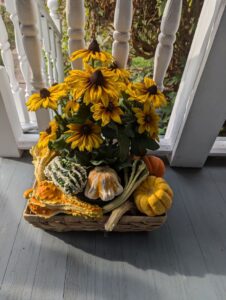 In 1919, a new popular song invaded the public conscience. Its title was, “How Ya Gonna Keep ’em Down on the Farm (After They’ve Seen Paree?)” World War I had just ended and many American soldiers had experienced Europe for the first time. Some of those not annihilated in trench warfare had been exposed to the high life of European cities, and the songwriters postulated that farm life back in America might prove too tame for the returnees.
In 1919, a new popular song invaded the public conscience. Its title was, “How Ya Gonna Keep ’em Down on the Farm (After They’ve Seen Paree?)” World War I had just ended and many American soldiers had experienced Europe for the first time. Some of those not annihilated in trench warfare had been exposed to the high life of European cities, and the songwriters postulated that farm life back in America might prove too tame for the returnees.
I thought of this the other day while looking at some highly ornamental rudbeckias or black-eyed Susans. During the last third of the twentieth century and the first quarter of the twenty-first, two native North American wildflowers, Rudbeckia fulgida, also known as “the orange coneflower”, and Rudbeckia hirta, generally known as the common black-eyed Susan, made their way to Europe and experienced the horticultural version of the high life. Befriended by Pygmalion-esque plant breeders in Germany and elsewhere, these unassuming members of the daisy family were transformed into something large, colorful and sophisticated. Their ancestors in the southeastern and central United States would barely recognize them.
Now these colorful creatures are strutting their stuff in retail establishments and gardens everywhere, alongside the autumn mums and asters. Many of us are familiar with ‘Goldsturm’, a clump-forming rudbeckia with long, golden yellow petals surrounding a small central “cone”. It was bred in Germany—hence the name, which means “gold storm”. Other fulgida offspring feature “gold” prominently in their names. ‘Early Bird Gold’, a chance offspring of ‘Goldsturm’, tends to flower earlier than most other fulgida varieties, and continues to flower through the fall. ‘American Gold Rush’, looks much like ‘Goldsturm’, except for its more compact habit—one to two feet tall–which makes it more suitable for containers and small spaces. Even shorter, topping out at just over 12 inches, is ‘Blovi’, also sold as ‘Viette’s Little Suzy’, with long golden petals and a large central cone.
The number of Rudbeckia fulgida on the market is generous. The number of Rudbeckia hirta cultivars, sometimes called “gloriosa daisies”, is even larger. My front porch is currently home to ‘Carla’, which is about 16 inches tall, with upright stems and flowers featuring double rows of large golden-orange petals that shade to red at the bases, forming halos around the dark central cones.
When I did a little research, I found that ‘Carla’ is part of the trademarked Sunbeckia series of rudbeckias, and has no less than 16 sisters, all named after women. The Sunbeckias were, not surprisingly, bred by the German company, Bull Gartenbau or Bull Plant Genetics. The 17 Sunbeckias feature all boast the same large flowers on upright stems. Most, like ‘Carla’ bear double rows of petals, and many are bi-colors. Among them are the striking ‘Luna’, with rounded petals and large, deep red “halos” surrounding dark central cones. ‘Olivia’s’ petals are long and golden, but the cone is green instead of the usual dark brown. ‘Sarah’ forgoes the gold tones completely, with red-orange petals, and darker haloes that seem to merge into the dark cones.
Another German breeder, Benary, which also has an outpost in Dekalb, Illinois, has introduced varieties like ‘Autumn Colors’, where the vivid orange-red halo completely dominates each gold-petaled flower.
‘Prairie Sun’, which may actually be a non-German rudbeckia, is a taller variety that tops out at three feet, is a bi-color with a green cone, golden-orange halo and yellow petals.
In short, Rudbeckia hirta varieties abound.
With their floriferous natures, ease of culture and flashy good looks, the rudbeckias provide lots of garden color. Though many varieties have won prestigious horticultural industry awards, the plants were bred with an eye to quick fall color, and container culture. The plant tags even suggest that they can be grown as annuals.
Still, rubeckias are clump-forming perennials, and I intend to install ‘Carla’ in the garden, once the flowers have begun to fade. It is hardy in my USDA zone and I find it wasteful to discard a beautiful plant that might well return next year.
If you are of like mind, get your rudbeckias in the ground now, or wait until next spring and order some from an online or catalog vendor. Garden centers may not stock the plants in the spring, as they bloom later in the growing season. All rudbeckias like a sunny location and well drained soil. Water during dry spells and deadhead spent flowers to encourage further blooms.
At the very least, add colorful rudbeckias to your autumnal porch or patio displays. If you are looking for garden plants, check Bluestone Perennials, 7211 Middle Ridge Rd., Madison, OH 44057; 800-852-5243; www.bluestoneperennials.com. Print catalog available.
